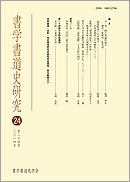Volume 2014, Issue 24
Displaying 1-8 of 8 articles from this issue
- |<
- <
- 1
- >
- >|
ARTICLES
-
2014Volume 2014Issue 24 Pages 1-14,119
Published: 2014
Released on J-STAGE: April 11, 2015
Download PDF (1128K) -
2014Volume 2014Issue 24 Pages 15-28,119-118
Published: 2014
Released on J-STAGE: April 11, 2015
Download PDF (30230K) -
2014Volume 2014Issue 24 Pages 29-41,118
Published: 2014
Released on J-STAGE: April 11, 2015
Download PDF (1093K) -
2014Volume 2014Issue 24 Pages 43-57,117
Published: 2014
Released on J-STAGE: April 11, 2015
Download PDF (3119K) -
2014Volume 2014Issue 24 Pages 59-73,117-116
Published: 2014
Released on J-STAGE: April 11, 2015
Download PDF (2063K)
STUDY-NOTES
-
2014Volume 2014Issue 24 Pages 75-92,116
Published: 2014
Released on J-STAGE: April 11, 2015
Download PDF (16635K)
SPECIAL LECTURE
-
2014Volume 2014Issue 24 Pages 93-103
Published: 2014
Released on J-STAGE: April 11, 2015
Download PDF (1874K)
-
2014Volume 2014Issue 24 Pages 105-112
Published: 2014
Released on J-STAGE: April 11, 2015
Download PDF (1000K)
- |<
- <
- 1
- >
- >|
